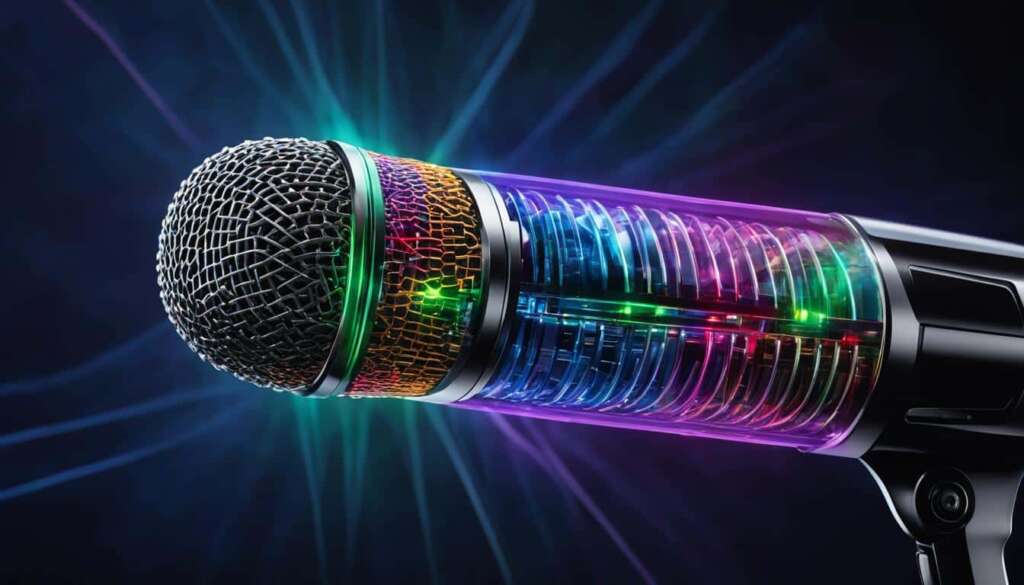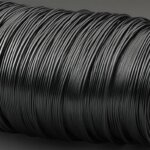Table of Contents
A microphone is a device used to convert sound waves into electrical signals. It is an essential tool for audio capture technology, enabling efficient recording and transmission of sound in various settings. Microphones come in different shapes and sizes, each serving a specific purpose and producing unique audio characteristics.
In this guide, we will explore the fundamentals of microphones, including their definition, uses, and the different types available for various applications. Whether you are a sound engineer, a content creator, or simply interested in understanding microphone technology, this guide will equip you with the knowledge needed to make informed decisions when selecting a microphone.
Key Takeaways
- Microphones convert sound waves into electrical signals.
- Microphones play a crucial role in audio capture technology.
- There are various types of microphones, each with unique audio characteristics.
- Microphones are used in a range of industries and activities, from music production to public speaking.
- Understanding microphone technology is essential for selecting a microphone that suits your needs.
Defining Microphones: An Overview
In order to understand the role of microphones in audio capture technology, it’s important to have a fundamental understanding of what a microphone is and how it functions. At its basic definition, a microphone is an electroacoustic transducer that converts sound into an electrical signal. The primary purpose of a microphone is to capture sound and convert it to a format that can be recorded, amplified, or transmitted.
There are several different types of microphones, each suited for different settings and applications.
| Microphone | Description |
|---|---|
| Dynamic Microphone | A basic type of microphone typically used for live performances or recording vocals due to its ability to handle high sound pressure levels. |
| Condenser Microphone | A type of microphone that is more sensitive than a dynamic microphone, commonly used for recording instruments or in-studio vocal performances due to its ability to capture more detail and nuance in sound. |
| Ribbon Microphone | A type of microphone that is known for its warm and natural tone, often used for recording guitar amps, brass instruments, and drum overheads. |
| Lavalier Microphone | A type of microphone that is typically worn on clothing or hidden in a set to capture dialogue or speech in video production or public speaking settings. |
Each type of microphone has its own unique characteristics and strengths, making it important to choose the right microphone for the specific application. By understanding the differences between microphone types, individuals can ensure that they are capturing sound in the most effective and efficient way possible.
Applications of Microphones
When it comes to microphone uses, the possibilities are vast and varied, with applications spanning across a multitude of industries and activities. Some of the most common applications for microphones include:
- Music production and recording: Microphones are used to capture the sounds of musical instruments, vocals, and ambient sounds during the recording process. Certain microphone types, such as condenser microphones, are particularly suitable for capturing the nuances of vocals and acoustic instruments.
- Live performances: Microphones are essential for amplifying the sounds of performers during live events. Dynamic microphones are commonly used for this purpose, as they can handle high sound pressure levels and are less sensitive to feedback.
- Broadcasting: Microphones play a crucial role in broadcasting, whether it’s for television news, radio, or podcasts. Condenser microphones with directional pickup patterns are often preferred for capturing clear, focused sound without picking up unwanted noise and interference.
- Public speaking: Microphones are widely used for public speaking events, conferences, and lectures, making it easier for speakers to project their voices and communicate effectively with large audiences. Lavalier microphones, also known as lapel microphones, are commonly used in these settings due to their inconspicuous size and ease of use.
It’s worth noting that certain microphone types are more suitable for specific applications than others. For instance, dynamic microphones are ideal for live sound reinforcement due to their ruggedness and ability to handle high sound pressure levels, while condenser microphones are typically preferred for studio recording and broadcasting due to their clarity and versatility. Furthermore, microphone features such as directional pickup patterns, frequency response, and impedance can also play a significant role in determining which microphone type is best suited for a particular application.
Ultimately, the various applications of microphones highlight their versatility and importance in the modern world of audio technology. With the right microphone in hand, anyone can capture high-quality sound and deliver their message with clarity and impact.
Conclusion
In summary, understanding the basics of microphone technology is crucial for anyone working in audio-related fields or simply interested in capturing high-quality sound. As we’ve explored in this guide, microphones come in various types, each with specific features and characteristics that make them suitable for different applications.
Whether you’re a musician, podcaster, broadcaster, public speaker or audio enthusiast, selecting the right microphone for your needs requires careful consideration of its intended use. While dynamic microphones are great for live performances and recording loud sources, they may not be the best choice for capturing subtle nuances in a studio recording. Similarly, lavalier microphones may be an excellent choice for public speaking or conferences, but they may not be ideal for music production or broadcasting.
Ultimately, by gaining a greater understanding of microphone technology and its applications, individuals can make informed decisions when selecting the right microphone for their intended use. So, whether you’re looking to invest in a new microphone or simply curious about the role of microphones in audio capture technology, we hope this guide has provided a helpful introduction to this fascinating subject.
FAQ
What is a microphone?
A microphone is an electronic device that converts sound waves into electrical signals, allowing for the capture and recording of audio.
What are the different types of microphones?
There are several types of microphones available, including dynamic microphones, condenser microphones, ribbon microphones, and lavalier microphones. Each type has its own unique characteristics and is suitable for different applications.
What are the uses of microphones?
Microphones have a wide range of uses across various industries and activities. They are commonly used in music production and recording, live performances, broadcasting, podcasting, public speaking, conferences, and more.
How do I choose the right microphone for my needs?
When selecting a microphone, consider the specific requirements of your application, the environment in which it will be used, and the desired sound quality. Consulting with audio professionals and conducting research on different microphone types can help you make an informed decision.













